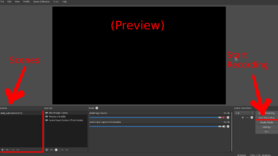
- Obs studio recording install#
- Obs studio recording drivers#
- Obs studio recording zip#
- Obs studio recording windows#

The reason for this is that your old-school VHS tapes use a resolution that will not look correct when played back on a typical computer or phone screen (it will look a bit stretched).

If you’ll be digitizing your tapes for use on a modern device (like a computer or a phone) use one of these for the “Output (Scaled) Resolution” setting: NOTE: You’ll need to highlight the current resolution and type your Base (Canvas) Resolution in, as it’s not available in the dropdown. The PAL region is a television publication territory that covers most of Asia, Africa, Europe, South America and Oceania.
Obs studio recording install#
Open the “Sound, video and game controllers” section and make sure that “USB 2828x Audio Device” and “USB 2828x Device” are shown, as shown below.ĭownload and install OBS – Configure OBS
Obs studio recording windows#
To verify that the adapter has been correctly installed, open your device manager by right clicking the Windows button and choosing “Device Manager” as shown below. Plug in the AdapterĪfter you’ve connected the cables from the VCR to the adapter, go ahead and plug the adapter into an available USB port on your computer.
Obs studio recording zip#
Once downloaded, extract the zip and run the Setup file from within the “Windows” folder.
Obs studio recording drivers#
If you purchased the device that I recommended, download the latest drivers from here (use the “Drivers & Downloads” tab).

I used this one from Amazon, which is $40 RCA Cables and (if applicable) an S-Video cable (depends on your VCR).OBS is an incredibly versatile (and free) tool, and it can even be used to digitize VHS tapes with an inexpensive piece of hardware (and a VCR, of course). If you’d rather watch a video tutorial, you can do so below: If you are interested in capturing lossless, 4:2:2 video files, have a look at this post. The updated converter records audio in stereo, captures both fields of video, and is verified to work with Windows 11. NOTE: This post was updated in January, 2022, and references a different USB converter than the one I had previously suggested in 2021.


 0 kommentar(er)
0 kommentar(er)
